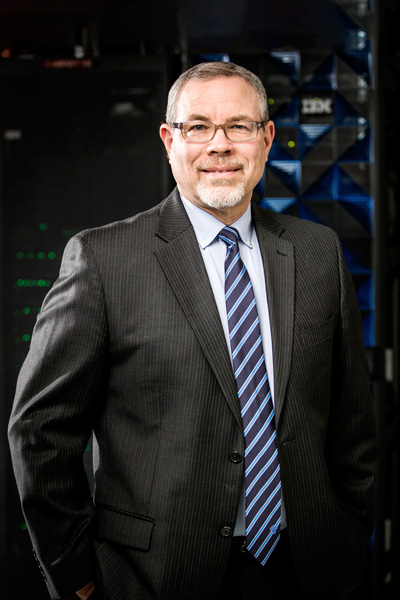
Build a foundation.
When I entered college, I was interested in mathematics, but I wasn’t sure how I would apply it. So I branched out into business finance. Because of that, I was required to take a basic computer programming class. I was hooked. I realized programming had the creative, analytic, and problem-solving elements I liked in mathematics, but took it in a more practical direction. I ended up with a dual major in computer science and business finance. When I graduated, there was no doubt I wanted to be in computer science.
Integrate using trusted vendors.
I worked at Northwest Airlines during a tumultuous time, so I learned a lot about change management. The airline went through a merger that included combining IT systems. When I started at the credit union, they were hamstrung with a too-diverse portfolio of hardware and software vendors. My prior experience taught me how to consolidate and create a core of trusted partners.
Now we’ve standardized significantly with a core group of strategic vendors: IBM, Cisco, and EMC, along with AT&T for telecom. On the application side, we primarily use the Symitar banking platform from Jack Henry and Associates. By having a few trusted partners, it greatly improves our overall systems integration and reliability. We’ve chosen the top-rated industry leaders of these particular areas. Because of that, we have a lot fewer problems because being leading edge makes them compatible with a wider range. Also, the leaders tend to be strongest in terms of support.
“The long-term battle for financial services to consumers is going to be won and lost on the technology playing field.”
Leverage your team.
Everybody needs to work together to produce your organization’s end product. At the airline, it was on-time performance and high customer satisfaction. In order to achieve that, every morning, seven days a week, we had an ops meeting. Everyone from line maintenance—including mechanics, pilots, and flight dispatchers—called in.
I brought a similar process to Tinker. The meeting is for all IT staff, not just my managers, and we cover any changes planned for that day up through the upcoming weekend. So everyone is on board and on the same page. A nice side effect of that process is it also helps build our team.
Size matters.
EDS had 140,000 employees. American Airlines, 110,000. I’ve been a small fish in a big pond for most of my career. When I joined Tinker, we had around 300 employees. To my surprise, the challenges that we face day-to-day are very similar to the bigger companies. When you add in the burdens of regulation that have surfaced in banking, what I thought would be a less complex job turned out just as complex. Even though it’s a relatively small company, you have to approach the job the same way. The stakes are high. It’s not an easier job.
Keep scale in mind.
As a $3.2 billion credit union, we are the forty-second largest credit union in the United States out of about 6,600 total credit unions. We have had rapid growth over the last ten years, so in IT we look for systems that can scale. Tinker has almost tripled in size over my twelve years through just organic growth. But going forward, as the whole banking industry changes and consolidates—we are prepared for whatever happens, including mergers if we have to grow that way. If we had to double our transactions overnight, we could do so because we have built a scalable systems architecture.
An industry in flux.
Not everyone agrees, but banks and credit unions are basically becoming technology companies whether they like it or not. Twenty years ago, people went to their bank to conduct transactions, get loans, develop relationships, or manage their finances. Technology now allows consumers to do that banking via self-service.
Banks and credit unions are now going all online. We launched our mobile banking check deposit in September of 2013. Since launch to November of 2014, we have grown from zero checks deposited per month via mobile phones to more than 20,000.
Nothing is sacred.
Tinker has offered all the products and services that most other leading financial institutions offer to their members. Now, we’re looking at revamping and offering the next generation of services. We want to continue to provide members the capability to perform transactions in an intuitive, user-friendly manner that will continue to evolve into new categories like wearables. We also want to get better at being able to provide service remotely, where members could actually talk to a trusted credit union subject-matter expert with a Skype-type experience. We believe that providing a consistent, high level of service through any channel that a member wants to engage in is the future.
The long-term battle for financial services to consumers is going to be won and lost on the technology playing field. Companies that can deliver sound, fast, reliable, and secure technology are going to win. Those that fall short are going to fall by the wayside.
Photo by David McNeese
